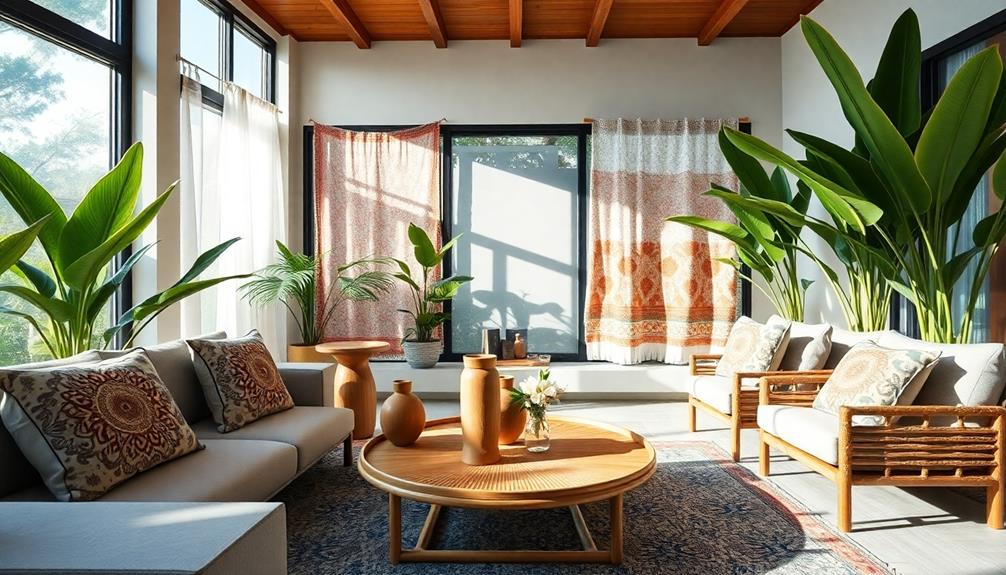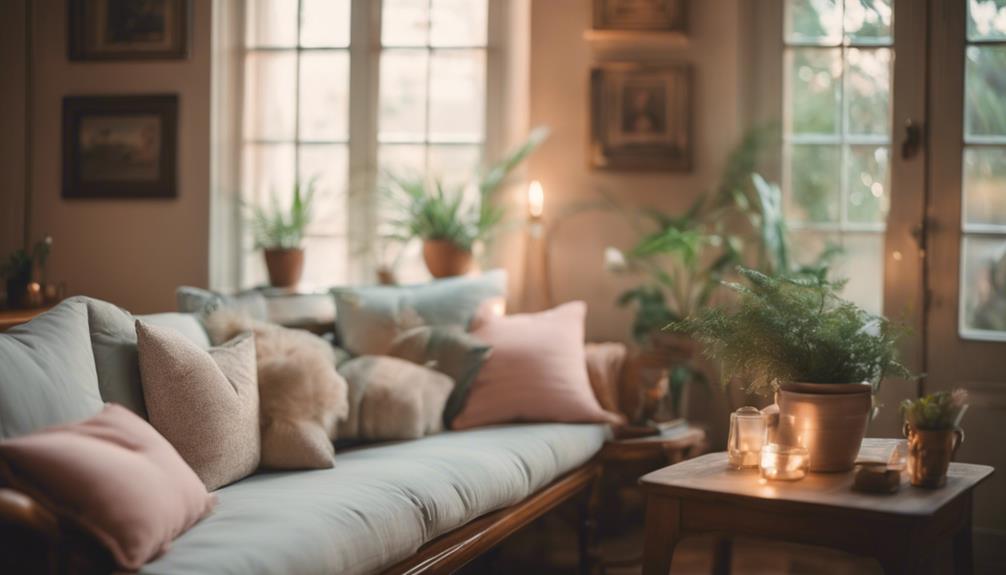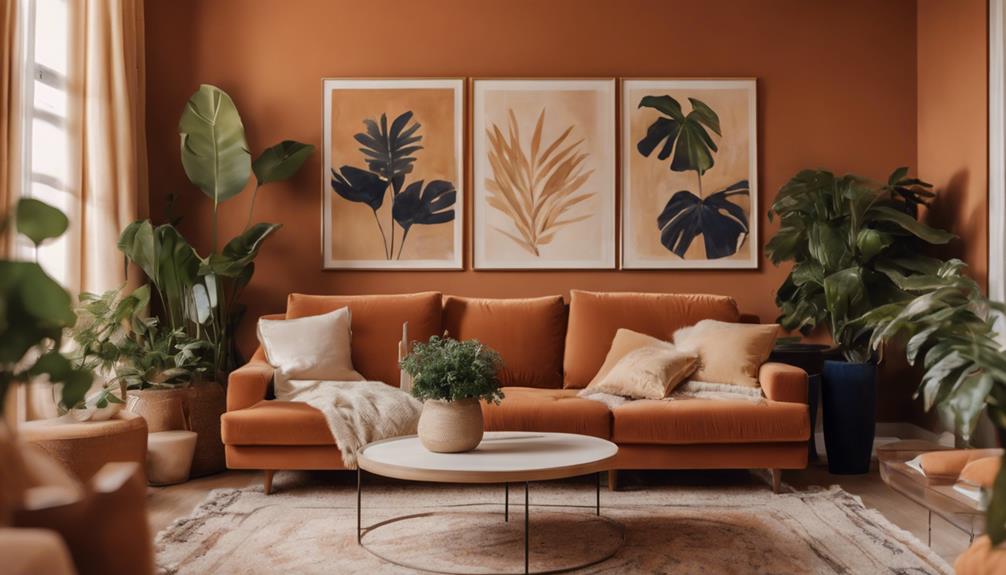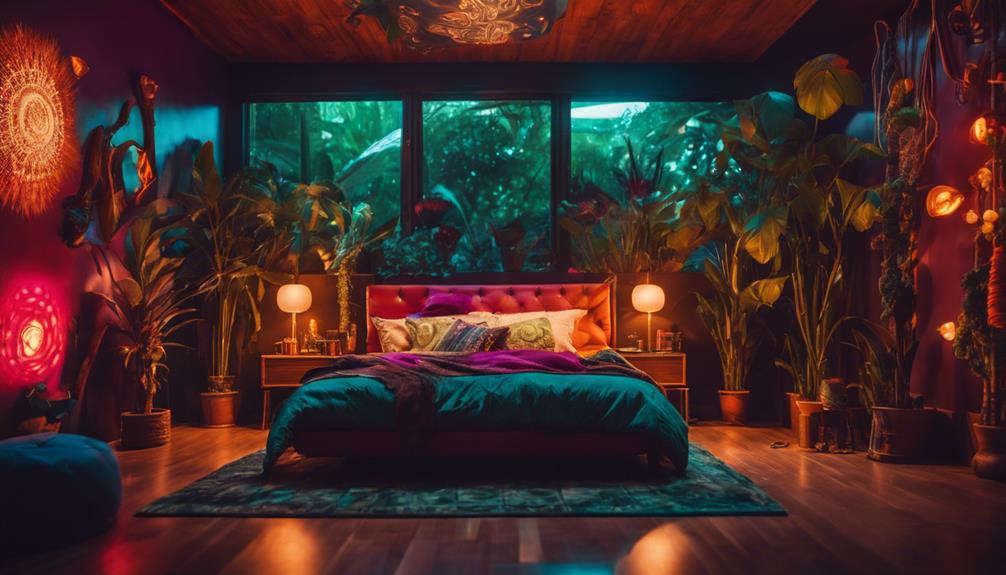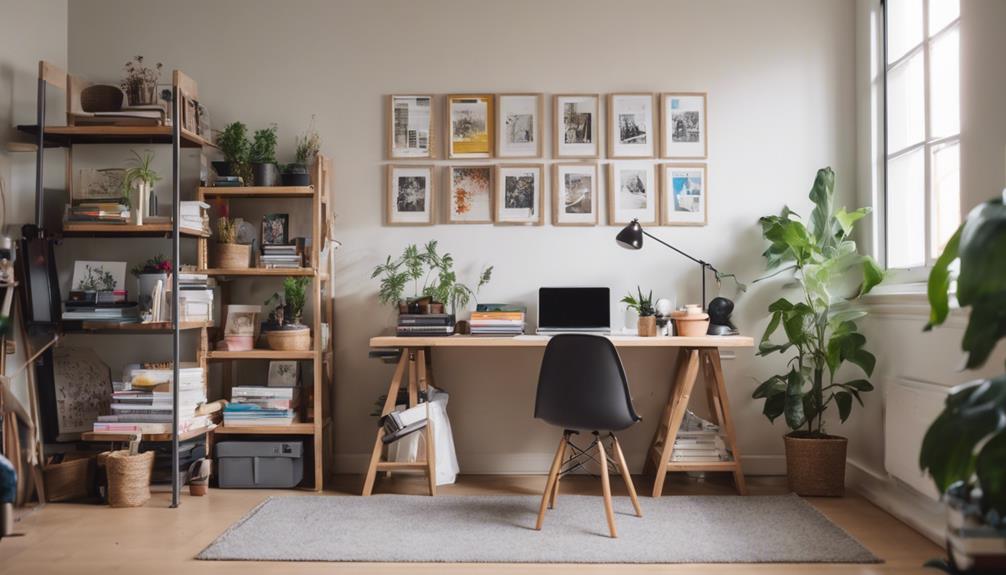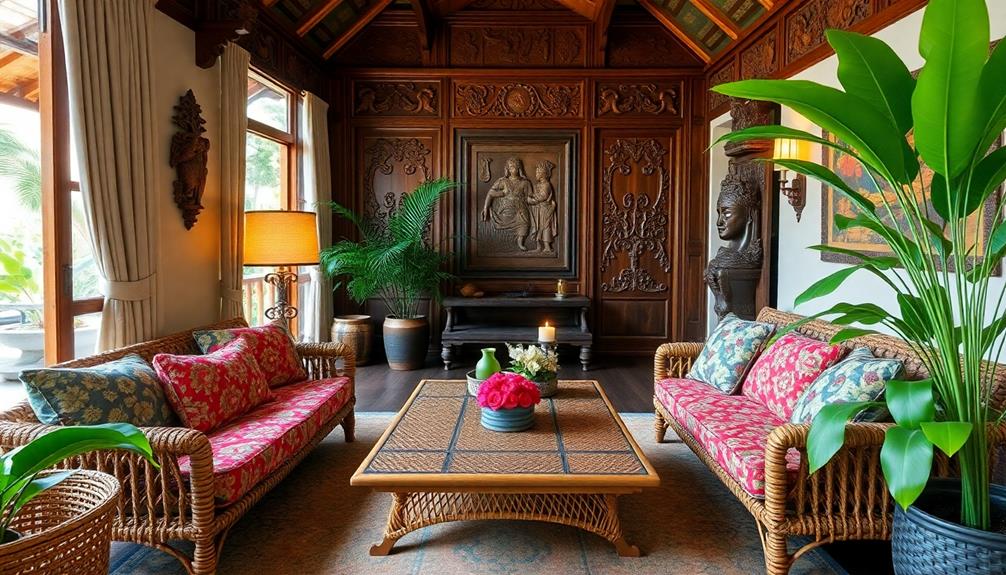You can effortlessly infuse your modern interior with vibrant Indonesian elements that reflect rich traditions and craftsmanship. Consider using rattan for sustainable and stylish furniture, or adorn your space with batik patterns that showcase intricate designs. Add character with stunning wood carvings from Bali, which tell stories of Indonesian culture. Incorporating Wayang puppets as decorative art brings a unique touch and serves as a conversation starter. By combining these elements, your home becomes a beautiful blend of modern aesthetics and cultural heritage. There's so much more to explore in elevating your interior style with these fascinating details.
Key Takeaways
- Rattan furniture adds sustainable elegance to modern interiors, showcasing Indonesia's craftsmanship and versatility for both indoor and outdoor use.
- Batik textiles enhance home decor with vibrant patterns, reflecting Indonesian culture while integrating seamlessly into various design styles.
- Wayang puppets serve as unique decorative art pieces, enriching interiors with cultural narratives and artistic flair rooted in Indonesian heritage.
- Intricate wood carvings from Bali offer warmth and character, depicting mythological scenes that connect modern spaces to Indonesia's rich cultural history.
- Natural materials like bamboo and antique wood promote eco-friendly design while celebrating traditional Indonesian craftsmanship in contemporary interiors.
Significance of Rattan

Rattan is more than just a material; it's a symbol of sustainable design and craftsmanship that enhances modern interiors. When you choose rattan for your interior design projects, you're embracing a versatile and durable option that's perfect for both indoor and outdoor settings.
Its weather resistance makes it a top choice for outdoor furniture, while its natural aesthetic brings warmth and texture to any space. Additionally, incorporating elements like traditional craftsmanship can further enrich your design narrative and elevate the cultural significance of your decor.
Indonesia stands out as the largest producer of natural rattan, with Cirebon, West Java, leading the charge. By incorporating rattan into your design aesthetic, you not only celebrate Indonesian craftsmanship but also connect your space to eco-friendly practices.
The increasing luxury status of rattan in global markets, including Europe, the USA, and Japan, reflects its rising demand and versatility.
Rattan's unique natural tones and textures invite a sense of comfort and style, making it an ideal addition to modern interiors. With rattan, you're not just making a design choice; you're investing in sustainability and supporting traditional craftsmanship while creating an inviting atmosphere in your home.
Embrace the significance of rattan and elevate your interior design today.
The Art of Batik
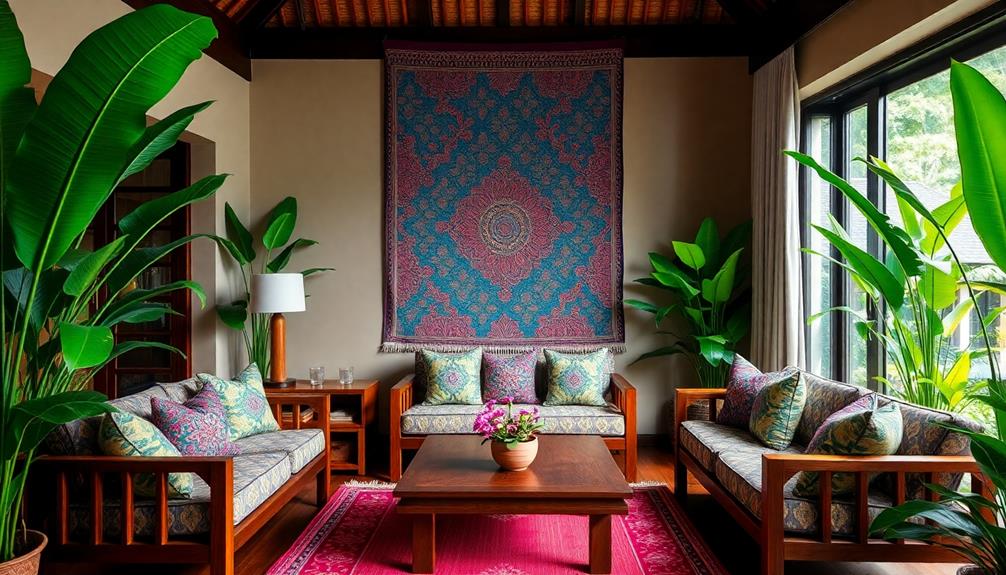
Batik isn't just a textile; it's a vibrant expression of Indonesian culture that's found its way into modern interiors.
With its intricate designs and rich symbolism, batik beautifully complements various decor styles, from contemporary to traditional.
You'll discover a range of techniques and styles that make batik versatile for various applications, from pillowcases to wall hangings.
Batik Techniques and Styles
Often celebrated for its intricate designs, the art of batik showcases a unique wax-resist dyeing technique that has captivated both traditionalists and modern designers alike. Originating in ancient Java, this textile art form produces stunning patterns that tell stories of Indonesia's rich culture.
As you explore batik, you'll be able to see how its techniques have evolved. Contemporary batik incorporates digital printing and modern design elements, making it appealing to a global audience. Additionally, Indonesian decor masks exemplify the vibrant artistry that reflects rich cultural traditions, further enriching the aesthetic of modern interiors.
Batik patterns extend beyond clothing and have made their mark in interior design. You'll find these beautiful motifs on items like pillowcases, carpets, and wall hangings, enhancing spaces with their vibrant colors and intricate details.
The versatility of batik allows it to complement various color palettes and aesthetics, seamlessly fitting into both traditional and modern settings.
As batik gains popularity around the world, it's reflecting a growing appreciation for this culturally rich art form. By integrating batik into your home décor, you not only embrace its beauty but also celebrate its heritage, creating a unique blend of tradition and contemporary style that stands out in any interior space.
Contemporary Batik Applications
The vibrant patterns of batik textiles have found a new life in contemporary design, transforming everyday items into striking pieces of art. This evolution maintains the traditional roots of batik while embracing innovative techniques that appeal to modern aesthetics. You'll see batik motifs on various items like pillowcases, carpets, and wall hangings, enhancing the visual appeal of your spaces.
The versatility of batik allows it to blend seamlessly with a wide range of color palettes, making it a popular choice for creating cohesive and stylish interiors. With a growing global demand, batik is not just a decorative choice but a celebration of Indonesian cultural heritage that fits contemporary trends. The intricate patterns and craftsmanship of these textiles add a unique artistic flair, enriching your environment with storytelling elements and cultural significance.
Here's a quick look at some popular contemporary batik applications:
| Item Type | Description |
|---|---|
| Pillowcases | Decorative and functional |
| Carpets | Grounding focal points |
| Wall Hangings | Artistic statement pieces |
| Table Linens | Elegant dining accessories |
| Clothing | Fashion-forward wearable art |
Incorporating batik into your décor is an exciting way to embrace tradition while enjoying modern design.
Batik in Interior Design
Incorporating batik into your interior design not only showcases its rich cultural heritage but also elevates your space with its unique artistry. This traditional Indonesian textile art form, originating from Java, utilizes wax and dye techniques that have evolved into contemporary styles, perfect for modern interiors.
You can easily integrate batik patterns into various home decor items, such as pillowcases, carpets, and wall hangings, allowing you to complement a wide range of color palettes and aesthetics. Additionally, these textiles align beautifully with the principles of traditional Indonesian style home decor, emphasizing natural materials and harmony with nature.
Contemporary batik designs often feature intricate motifs that enhance visual interest and depth, making them an excellent choice for adding artistic flair to any room. The global popularity of batik has led to its increased presence in home decor markets, reflecting a growing appreciation for cultural diversity and authenticity in design.
Moreover, batik textiles contribute considerably to sustainable design practices. Many utilize natural dyes and materials, aligning with today's eco-friendly interior trends.
Enchantment of Wayang Puppets
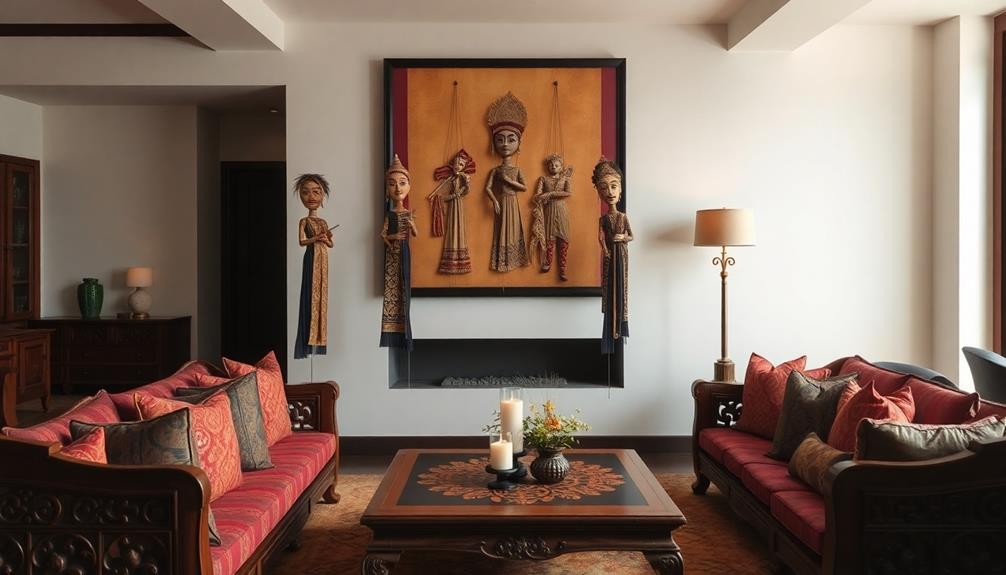
Wayang puppets aren't just artistic creations; they embody a rich cultural narrative that connects you to Indonesia's heritage.
Their intricate designs often depict local myths and folklore, making them a stunning representation of Indonesian decor masks which enhance any space with their charm.
Their versatility allows you to incorporate these unique pieces into various styles of modern interiors, enhancing any space with their charm.
You might also find fresh interpretations of these puppets that celebrate tradition while fitting seamlessly into contemporary design.
Cultural Significance of Wayang
While exploring the enchanting world of Indonesian culture, you can't overlook the significance of Wayang puppetry. Originating in Java during the 10th century, this art form is a mesmerizing blend of storytelling and entertainment, deeply rooted in Hindu traditions.
Wayang puppets come in two primary types:
- Wayang Kulit: Made from leather, these puppets cast striking shadows during performances.
- Wayang Golek: Crafted from wood, these three-dimensional figures bring a unique tactile experience.
Incorporating elements like Indonesian decorative pillows can further enhance the aesthetic of your space while celebrating the culture. Traditionally seen as souvenirs, Wayang puppets have evolved into decorative art pieces that enhance modern interiors.
Their intricate designs often depict mythological figures and scenes from everyday life, showcasing Indonesia's rich cultural heritage. As you incorporate these artistic elements into your space, you not only bring beauty but also a narrative depth that resonates with the history of the region.
The craftsmanship involved in creating these puppets reflects the skill and artistry of Indonesian culture, making them cherished elements in contemporary decor. By embracing Wayang puppetry, you celebrate a significant aspect of Indonesia's identity, enriching your home with stories and traditions that span centuries.
Design Versatility in Interiors
Bringing the enchanting art of Wayang puppetry into your living space opens up a world of design possibilities. Originating in Java during the 10th century, these puppets offer rich cultural narratives that can seamlessly integrate into your modern interiors. You can choose from two main types: Wayang Kulit, with its intricate leather designs, or Wayang Golek, featuring beautifully carved wooden figures. Each type presents unique aesthetic options to enhance your home decor.
Additionally, incorporating traditional motifs from Indonesian culture can further enrich your design scheme, creating a harmonious blend of old and new.
Contemporary applications of Wayang puppets are diverse, allowing you to use them as figurines, sculptures, or even striking wall art. Their intricate craftsmanship and storytelling elements create visual interest, adding a layer of artistic flair to your space. By incorporating these puppets, you not only beautify your environment but also celebrate Indonesian culture, fostering a sense of authenticity and heritage.
As you explore this design versatility, you'll find that Wayang puppets resonate with a growing appreciation for cultural diversity in interior design. They serve as conversation starters and can transform any room into a fascinating blend of tradition and modernity, making your home truly unique.
Modern Interpretations and Uses
The enchanting world of Wayang puppets has found a new life in modern interiors, transforming traditional art into alluring design elements. Originating in Java during the 10th century, Wayang puppetry evolved from religious storytelling to a celebrated decorative art form.
Today, both Wayang Kulit (leather) and Wayang Golek (wooden figures) serve as unique figurines and sculptures that enhance your living spaces. These puppets can beautifully complement Balinese design characteristics, creating a harmonious blend of culture and craftsmanship.
You can incorporate these stunning puppets in various ways:
- Wall Art: Hang intricate Wayang puppets to create a striking focal point in your room.
- Decorative Accents: Use them as centerpieces or accents on shelves to spark conversation.
- Cultural Statements: Showcase your appreciation for Indonesia's rich heritage through these artistic pieces.
Once mere souvenirs, Wayang puppets now hold significant cultural value, adding depth and character to modern interiors. Their craftsmanship and storytelling capabilities resonate with a global audience, reflecting a growing interest in authentic cultural items.
As you explore contemporary design trends, consider how these enchanting puppets can elevate your space, merging tradition with modern aesthetics seamlessly.
Mastery of Wood Carvings
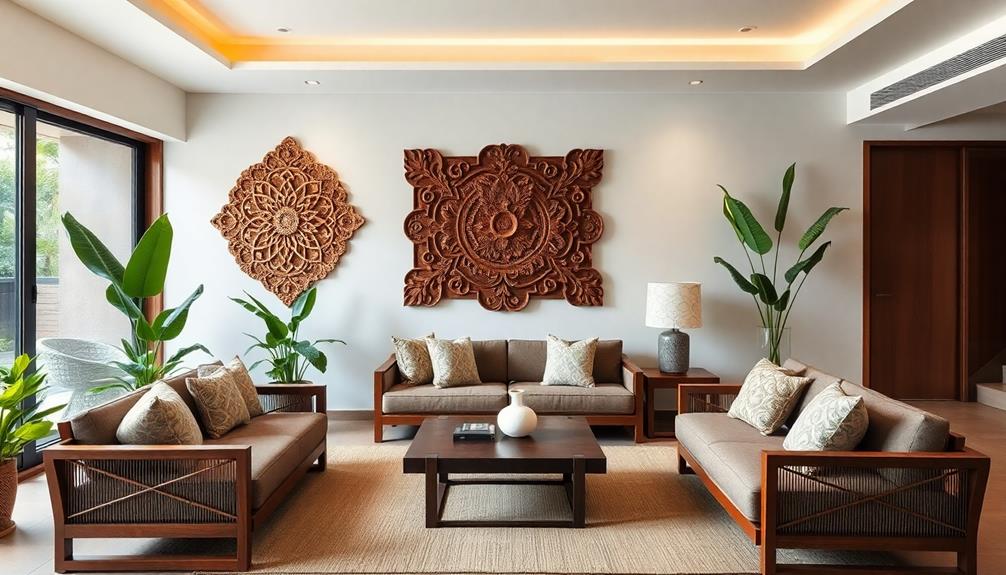
Mastery of wood carvings in Indonesia, particularly from Bali, showcases an extraordinary blend of artistry and cultural significance. These intricate carvings have a rich history dating back to the 13th century, originally crafted for religious purposes.
Today, they're celebrated for their detailed craftsmanship, often depicting mythological figures and daily life scenes that reflect Indonesia's diverse cultural heritage. Many interior design shops in Bali, such as those specializing in luxury tropical designs, often incorporate these wood carvings into their projects to enhance the aesthetic appeal of modern interiors.
Since the 1930s, Indonesian wood carvings have been exported globally and are now commonly found in homes and hotels. Their unique designs enhance aesthetic appeal, making them sought-after decorative elements.
You can utilize these versatile carvings in various forms, including headboards, wall art, and decorative statues, all of which contribute warmth and character to your interior spaces.
Moreover, the craftsmanship behind these wood carvings supports sustainable design practices. Artisans often use locally sourced materials, fostering a deep connection between your interiors and nature.
Cultural Heritage in Design

Cultural heritage enriches modern design by infusing spaces with stories and artistry that reflect Indonesia's diverse history. When you incorporate traditional Indonesian design elements, you're not just decorating; you're telling a story that resonates with the rich cultural tapestry of the archipelago.
For instance, the emphasis on modern tropical aesthetics brings a seamless blend of indoor and outdoor environments, enhancing the overall ambiance of your space.
- Intricate craftsmanship: Traditional carvings depict mythological figures and daily life scenes, adding depth to your space.
- Batik patterns: This ancient textile art from Java brings a unique cultural identity, effortlessly complementing various aesthetics while showcasing versatility.
- Wayang puppetry: Originally souvenirs, these decorative art pieces highlight a crucial aspect of Indonesian culture, enhancing the aesthetic appeal of modern interiors.
Natural Materials in Interiors
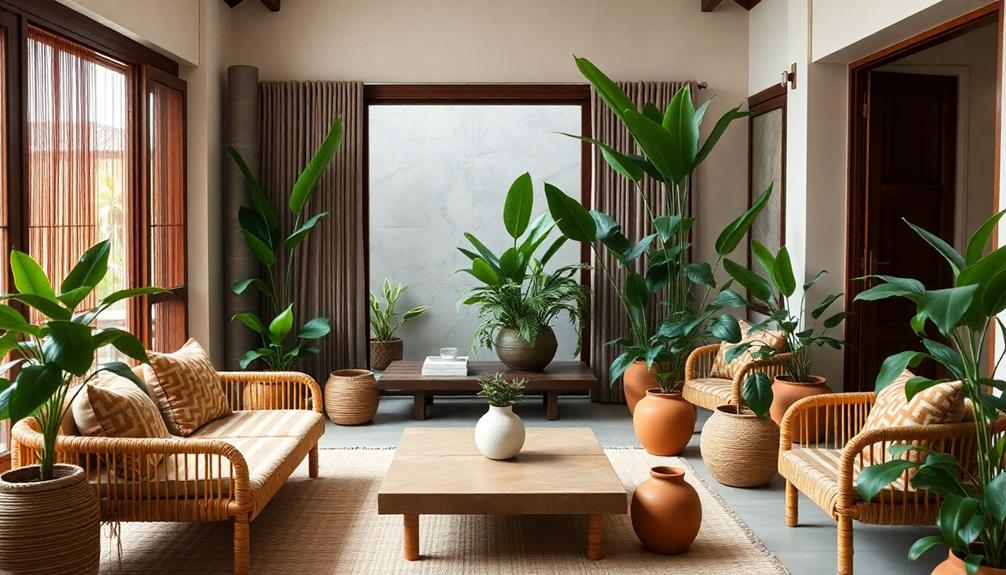
Incorporating natural materials in interiors can transform your space into a serene oasis that connects you with the environment. In Indonesian design, materials like rattan and bamboo take center stage, emphasizing sustainability and a seamless connection to nature.
Traditional Indonesian housing often utilizes these materials to create elevated structures that are both functional and beautiful, reflecting the region's architectural heritage. Rattan, for example, isn't only durable but also weather-resistant, making it a versatile choice for both indoor and outdoor furniture. You can easily enhance your modern designs with this timeless material.
Antique wood sourced from Indonesia brings character and warmth to your interiors, enriching the aesthetic appeal of your space. This wood's unique textures and grains add depth and authenticity that mass-produced materials simply can't replicate.
By opting for natural materials, you're supporting eco-friendly practices that create a comfortable and inviting atmosphere, aligning with the principles of traditional Indonesian housing.
Integrating these elements reflects a rich cultural heritage, making your home not just a living space but a representation of authenticity and uniqueness.
Frequently Asked Questions
How Can I Incorporate Indonesian Elements in Small Spaces?
To incorporate Indonesian elements in small spaces, you can use vibrant textiles, add bamboo accents, and showcase unique artifacts. Consider small potted plants for a tropical feel, and utilize mirrors to create an illusion of space.
What Colors Represent Traditional Indonesian Design?
Imagine walking through a vibrant market; colors like deep reds, earthy browns, and lush greens capture Indonesia's spirit. You can use these hues to evoke warmth and tradition in your design, making spaces feel alive.
Where Can I Find Authentic Indonesian Decor Items?
You can find authentic Indonesian decor items at specialty shops, online marketplaces, or local artisan fairs. Check out websites that focus on handmade goods or visit cultural festivals showcasing Indonesian craftsmanship for unique pieces.
Are There Modern Indonesian Designers to Follow?
You won't believe the creative genius of modern Indonesian designers! Check out names like Andra Matin and Dody Susanto. Their work blends tradition with innovation, making them must-follow talents for any design enthusiast. You'll be inspired!
How Do I Maintain Traditional Indonesian Textiles?
To maintain traditional Indonesian textiles, you should regularly clean them with a soft brush, avoid direct sunlight, and store them in a cool, dry place. It's essential to treat any stains gently and promptly.
Conclusion
By weaving traditional Indonesian elements into modern interiors, you create a vibrant tapestry of culture and design. Imagine rattan furniture cradling you in comfort, batik patterns wrapping your walls in stories, and wooden carvings whispering tales of craftsmanship. Each piece not only enhances your space but also honors a rich heritage. So, why not invite these enchanting elements into your home? Let them transform your surroundings into a sanctuary that celebrates the beauty of Indonesia's traditions.
